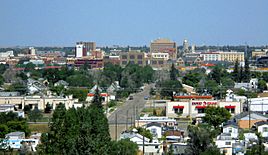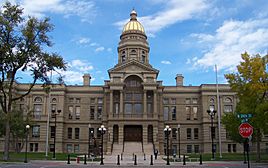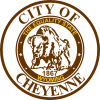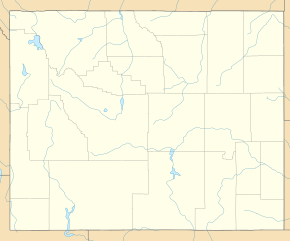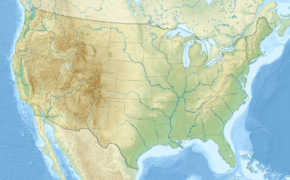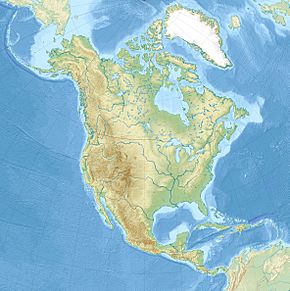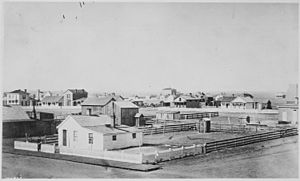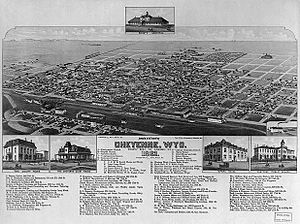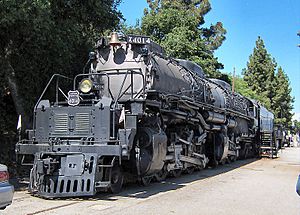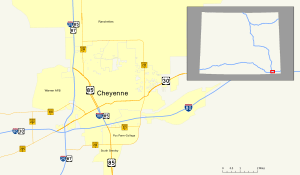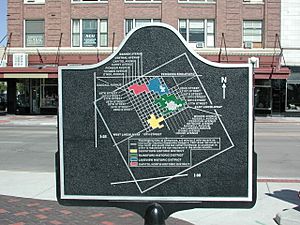Cheyenne, Wyoming facts for kids
Quick facts for kids
Cheyenne, Wyoming
|
|||
|---|---|---|---|
|
State capital and city
|
|||
| City of Cheyenne | |||
|
Left to right from top: Downtown Cheyenne, Cheyenne Depot Museum, Union Pacific Big Boy 4004 and the Wyoming State Capitol
|
|||
|
|||
| Nickname(s):
"Magic City of the Plains" (historic)
|
|||
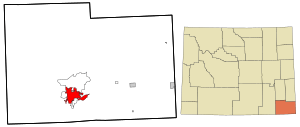
Location in Laramie County in Wyoming
|
|||
| Country | United States | ||
| State | Wyoming | ||
| County | Laramie | ||
| Founded | 1867 | ||
| Named for | Cheyenne people | ||
| Area | |||
| • City | 32.37 sq mi (83.84 km2) | ||
| • Land | 32.26 sq mi (83.55 km2) | ||
| • Water | 0.11 sq mi (0.29 km2) 0.45% | ||
| Elevation | 6,062 ft (1,848 m) | ||
| Population
(2020)
|
|||
| • City | 65,132 | ||
| • Density | 1,991.23/sq mi (768.82/km2) | ||
| Time zone | UTC−7 (Mountain) | ||
| • Summer (DST) | UTC−6 (Mountain) | ||
| ZIP Code |
82001–82003, 82006–82010
|
||
| Area code(s) | 307 | ||
| FIPS code | 56-13900 | ||
| GNIS feature ID | 1609077 | ||
| Highways | |||
Cheyenne ( SHY-an or SHY-en) is the capital and most populous city of the U.S. state of Wyoming, with 65,132 residents. It is the principal city of the Cheyenne metropolitan statistical area which encompasses all of Laramie County and has about 100,000 residents. Local residents named the town for the Cheyenne Native American people in 1867 when it was founded in the Dakota Territory.
Cheyenne is the northern terminus of the extensive Southern Rocky Mountain Front, which extends southward to Albuquerque, New Mexico, and includes the fast-growing Front Range Urban Corridor. Cheyenne is situated on Crow Creek and Dry Creek.
Contents
History
On July 5, 1867, General Grenville M. Dodge and his survey crew plotted the site now known as Cheyenne in Dakota Territory (later Wyoming Territory). This site was chosen as the point at which the Union Pacific Railroad crossed Crow Creek, a tributary of the South Platte River. The city was not named by Dodge, as his memoirs state, but rather by friends who accompanied him to the area Dodge called "Crow Creek Crossing". It was named for the American Indian Cheyenne nation, one of the most famous and prominent Great Plains tribes closely allied with the Arapaho.
The construction of the Union Pacific Railroad brought hopes of prosperity to the region when it reached Cheyenne on November 13, 1867. The population at the time numbered over 4,000, and grew rapidly. This rapid growth earned the city the nickname "Magic City of the Plains".
In 1867, Fort D. A. Russell was established, three miles west of the city. The fort was later renamed Francis E. Warren Air Force Base.
The Wyoming State Capitol was constructed between 1886 and 1890, with further improvements being completed in 1917.
The Wyoming Stock Growers Association met at The Cheyenne Club, which allegedly acted as an interim government for the territory. Many of the WSGA's rules and regulations became state laws.
The Cheyenne Regional Airport was opened in 1920, initially serving as a stop for airmail. It soon developed into a civil-military airport, serving DC-3s and various military craft. During World War II, hundreds of B-17s, B-24s, and PBYs were outfitted and upgraded at the airfield. Today, it serves a number of military functions, as well as a high-altitude testbed for civilian craft.
Geography and climate
Geography
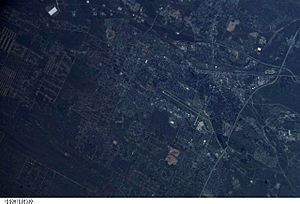
Lying near the southeast corner of the state, Cheyenne is one of the least centrally located state capitals in the nation (together with cities such as Carson City, Nevada; Juneau, Alaska; and Topeka, Kansas).
According to the United States Census Bureau, the city has a total area of 24.63 square miles (63.79 km2), of which, 24.52 square miles (63.51 km2) is land and 0.11 square miles (0.28 km2) is water.
Climate
Cheyenne, like most of the rest of Wyoming, has a cool semi-arid climate (Köppen BSk), and is part of USDA Hardiness zone 5b, with the suburbs falling in zone 5a. Winters are cold and moderately long, but relatively dry, with a December average of 28.8 °F (−1.8 °C), highs that fail to breach freezing occur 35 days per year, and lows dip to the 0 °F or −17.8 °C mark on 9.2 mornings. However, the cold is often interrupted, with chinook winds blowing downslope from the Rockies that can bring warm conditions, bringing the high above 50 °F or 10 °C on twenty days from December to February.
Snowfall is greatest in March and April, seasonally averaging 60 inches or 1.52 metres, historically ranging from 13.1 inches (0.33 m) between July 1965 and June 1966 up to 121.5 inches (3.09 m) between July 1979 and June 1980, yet thick snow cover rarely stays. Summers are warm, with a high diurnal temperature range; July averages 69.4 °F or 20.8 °C, and highs reach 90 °F or 32.2 °C on an average twelve afternoons annually. Spring and autumn are quick transitions, with the average window for freezing temperatures being September 29 thru May 14, allowing a growing season of 106 days. Official record temperatures range from −38 °F (−38.9 °C) on January 9, 1875, up to 100 °F (37.8 °C) on June 23, 1954, the last of four occurrences; the record cold daily maximum is −21 °F (−29.4 °C) on January 11, 1963, while, conversely, the record warm daily minimum is 68 °F (20 °C) on July 31, 1960. The annual precipitation of 15.9 inches or 403.9 millimetres tends to be concentrated from May to August and is low during fall and winter; it has historically ranged from 5.04 inches (128.0 mm) in 1876 to 23.69 inches (601.7 mm) in 1942.
The city averages below 60% daily relative humidity in each month and receives an average 2,980 hours (~67% of the possible total) of sunshine annually. On July 16, 1979 an F3 tornado struck Cheyenne causing one death and 40 injuries. It was the most destructive tornado in Wyoming history.
| Climate data for Cheyenne Regional Airport, Wyoming (1981–2010 normals, extremes 1872−present) | |||||||||||||
|---|---|---|---|---|---|---|---|---|---|---|---|---|---|
| Month | Jan | Feb | Mar | Apr | May | Jun | Jul | Aug | Sep | Oct | Nov | Dec | Year |
| Record high °F (°C) | 66 (19) |
71 (22) |
77 (25) |
83 (28) |
91 (33) |
100 (38) |
100 (38) |
98 (37) |
95 (35) |
85 (29) |
75 (24) |
69 (21) |
100 (38) |
| Average high °F (°C) | 39.5 (4.2) |
40.5 (4.7) |
47.5 (8.6) |
54.9 (12.7) |
64.7 (18.2) |
75.3 (24.1) |
83.4 (28.6) |
81.2 (27.3) |
71.8 (22.1) |
58.8 (14.9) |
46.5 (8.1) |
38.2 (3.4) |
58.5 (14.7) |
| Average low °F (°C) | 18.0 (−7.8) |
18.6 (−7.4) |
24.4 (−4.2) |
30.8 (−0.7) |
40.2 (4.6) |
48.9 (9.4) |
55.5 (13.1) |
54.1 (12.3) |
44.7 (7.1) |
33.9 (1.1) |
24.2 (−4.3) |
17.3 (−8.2) |
34.2 (1.2) |
| Record low °F (°C) | −38 (−39) |
−34 (−37) |
−21 (−29) |
−8 (−22) |
8 (−13) |
25 (−4) |
33 (1) |
25 (−4) |
8 (−13) |
−5 (−21) |
−21 (−29) |
−28 (−33) |
−38 (−39) |
| Average precipitation inches (mm) | 0.33 (8.4) |
0.47 (12) |
1.05 (27) |
1.78 (45) |
2.34 (59) |
2.34 (59) |
2.19 (56) |
1.95 (50) |
1.48 (38) |
0.93 (24) |
0.59 (15) |
0.49 (12) |
15.94 (405) |
| Average snowfall inches (cm) | 5.9 (15) |
7.9 (20) |
11.3 (29) |
10.2 (26) |
2.3 (5.8) |
trace | 0 (0) |
0 (0) |
1.3 (3.3) |
5.0 (13) |
8.0 (20) |
8.4 (21) |
60.3 (153) |
| Average precipitation days (≥ 0.01 in) | 4.9 | 6.2 | 8.6 | 10.3 | 12.4 | 11.4 | 10.7 | 11.0 | 8.3 | 7.4 | 6.4 | 6.2 | 103.8 |
| Average snowy days (≥ 0.1 in) | 5.7 | 6.5 | 7.8 | 6.1 | 1.8 | 0.1 | 0 | 0 | 0.7 | 3.4 | 6.1 | 6.8 | 45.0 |
| Average relative humidity (%) | 52.5 | 54.6 | 56.1 | 54.3 | 55.8 | 53.5 | 51.3 | 51.4 | 51.5 | 50.0 | 53.6 | 54.0 | 53.2 |
| Mean monthly sunshine hours | 190.7 | 202.6 | 253.1 | 271.9 | 291.9 | 303.2 | 317.5 | 297.4 | 262.3 | 237.0 | 178.8 | 175.4 | 2,981.8 |
| Percent possible sunshine | 64 | 68 | 68 | 68 | 65 | 67 | 69 | 70 | 70 | 69 | 60 | 61 | 67 |
| Source: NOAA (relative humidity and sun 1961−1990) | |||||||||||||
Demographics
| Historical population | |||
|---|---|---|---|
| Census | Pop. | %± | |
| 1870 | 1,450 | — | |
| 1880 | 3,456 | 138.3% | |
| 1890 | 11,690 | 238.3% | |
| 1900 | 14,087 | 20.5% | |
| 1910 | 11,320 | −19.6% | |
| 1920 | 13,829 | 22.2% | |
| 1930 | 17,361 | 25.5% | |
| 1940 | 22,474 | 29.5% | |
| 1950 | 31,935 | 42.1% | |
| 1960 | 43,505 | 36.2% | |
| 1970 | 41,254 | −5.2% | |
| 1980 | 47,283 | 14.6% | |
| 1990 | 50,008 | 5.8% | |
| 2000 | 53,011 | 6.0% | |
| 2010 | 59,466 | 12.2% | |
| 2020 | 65,132 | 9.5% | |
| U.S. Decennial Census 1870–2000 census 2018 estimate |
|||
In 2020, Cheyenne had a total estimated population of 64,742. As of the census of 2010, there were 59,467 people, 25,558 households, and 15,270 families living in the city. The population density was 2,425.2 inhabitants per square mile (936.4/km2). There were 27,284 housing units at an average density of 1,112.7 per square mile (429.6/km2). As of the census of 2000, there were 53,011 people, 22,324 households, 14,175 families living in the city, and 81,607 people living in the metropolitan statistical area making it the largest city and metropolitan area in the state of Wyoming. The population density was 2,511.4 inhabitants per square mile (969.6/km2). There were 23,782 housing units at an average density of 1,126.7 per square mile (435.0/km2).
At the 2019 American Community Survey, the city had an owner-occupied housing rate of 65.9% with a median value at $214,300. There were 27,344 households from 2015 to 2019, and an average of 2.20 persons per household. Residents of Cheyenne had a median household income of $64,598 and per capita of $35,637. An estimated 10.4% lived at or below the poverty line.
In 2010, there were 25,558 households, of which 30.2% had children under the age of 18 living with them, 43.1% were married couples living together, 12.0% had a female householder with no husband present, 4.7% had a male householder with no wife present, and 40.3% were non-families. 33.5% of all households were made up of individuals, and 10.6% had someone living alone who was 65 years of age or older. The average household size was 2.29 and the average family size was 2.92. In 2000, there were 22,324 households, out of which 30.4% had children under the age of 18 living with them, 49.2% were married couples living together, 10.6% had a female householder with no husband present, and 36.5% were non-families. 31.3% of all households were made up of individuals, and 10.6% had someone living alone who was 65 years of age or older. The average household size was 2.33 and the average family size was 2.93.
The median age in the city was 36.5 years at the 2010 census. Twenty-four percent of residents were under the age of 18; 9.5% were between the ages of 18 and 24; 26.9% were from 25 to 44; 26.2% were from 45 to 64; and 13.5% were 65 years of age or older. The gender makeup of the city was 49.3% male and 50.7% female. In 2000, 24.9% under the age of 18, 8.8% from 18 to 24, 29.7% from 25 to 44, 22.8% from 45 to 64, and 13.8% 65 years of age or older. The median age was 37 years. For every 100 females, there were 95.3 males. For every 100 females age 18 and over, there were 92.7 males.
The median income for a household in the city was $38,856, and the median income for a family was $46,771. Males had a median income of $32,286 versus $24,529 for females. The per capita income for the city was $19,809. About 6.3% of families and 8.8% of the population were below the poverty line, including 11.1% of those under age 18 and 5.8% of those age 65 or over.
Ethnicity
The U.S. Census Bureau estimated the racial and ethnic makeup of the city was 89.5% non-Hispanic white, 2.0% Black or African American, 0.8% American Indian or Alaska Native, 1.5% Asian, 0.3% Native Hawaiian or other Pacific Islander, 3.9% two or more races, and 14.7% Hispanic or Latin American of any race, in 2019.
In 2010, the racial makeup of the city was 87.44% European American, 2.88% African American, 0.96% Native American, 1.24% Asian, 0.20% Pacific Islander, 4.0% from other races, and 3.28% from two or more races. Hispanic or Latino of any race were 14.45% of the population. At the 2005–2007 American Community Survey 3-Year Estimates, the city's population was 87.2% White or European American (79.3% non-Hispanic White alone), 12.7% Hispanic or Latino (of any race), 4.5% Black or African American, 2.5% American Indian and Alaska Native, 2.1% Asian and 6.4% from some other race.
In 2000, the racial makeup of the city was 88.1% White or European American, 2.8% Black or African American, 0.8% Native American, 1.1% Asian, 0.1% Pacific Islander, 4.4% from other races, and 2.7% from two or more races. 12.5% of the population were Hispanic or Latino of any race.
Parks and recreation
The Cheyenne Parks and Recreation Department operates an Ice and Events center, swimming pool, spray park, skateboard park, two golf courses, Cheyenne Botanic Gardens (including the Paul Smith Children's Village at the Gardens), paddle boat rentals in Lions Park (summers only), cemeteries, forestry operations, community house, Youth Activity Center and a miniature golf park. The Cheyenne Parks and Recreation Department also operates a 37-mile Greater Cheyenne Greenway system. The greenway connects parks and neighborhoods of greater Cheyenne. It includes many bridges and underpasses where travelers can avoid high traffic roads and travel above waterways and drainages. In 1996, as a result of the greenway, Cheyenne was named a "Trail Town USA" by the National Park service and the American Hiking Society.
Professional sports
The Cheyenne Warriors were founded as an American Professional Football League team in 2012. After playing a season in the APFL, they announced a move to the Indoor Football League. Shortly after the owner of the team died in December 2012, the Warriors announced that they were forming the new Developmental Football League. After playing several games in this new league, the team folded in May 2013.
Landmarks
- Wyoming State Capitol
- F.E. Warren Air Force Base, one of the nation's oldest, continuously active installations (originally U.S. Army).
- Nagle Warren Mansion
National Register of Historical Places
Over fifty different locations in Cheyenne are listed on the National Register of Historical Places, including:
- the Atlas Theatre (added 1973)
- Union Pacific Depot (1973)
- the Governor's Mansion (1969)
- Nagle-Warren Mansion (1976)
- First Presbyterian Church (1869)
- First United Methodist Church (1975)
- St. Mark's Episcopal Church (1970)
- St. Mary's Catholic Cathedral (1974)
- Cheyenne High School (2005)
- High Plains Horticulture Research Station a.k.a. High Plains Arboretum (1930–1974)
- Storey Gymnasium (2005)
- Park Addition School (1970)
- Big Boy Steam Engine (1956)
- Botanic Gardens Rotary Century Plaza & Steam Locomotive (1921)
Several districts in the city are also listed, including:
- the Downtown District (1978, with boundary increase in 1980, 1988, 1996. Encompasses 205 acres (0.83 km2) and 67 buildings)
- Lakeview District (1996, 350 acres 109 buildings)
- Rainsford District (1984, 1980 acres 288 buildings)
- Capitol North District (1980, 204 acres 112 buildings)
- Fort David A. Russell (1969, 6300 acres 19 buildings)
- Union Pacific Roundhouse, Turntable and Machine Shop (1992, 113 acres 2 buildings)
- South Side District (2006)
Transportation
Major highways
 I-25 – North–South Interstate running from New Mexico to Wyoming intersects I-80 southwest of Cheyenne.
I-25 – North–South Interstate running from New Mexico to Wyoming intersects I-80 southwest of Cheyenne. I-80 – East-West Interstate running from California to New Jersey. Intersects I-25 southwest of Cheyenne.
I-80 – East-West Interstate running from California to New Jersey. Intersects I-25 southwest of Cheyenne. I-180 – Bypass Interstate that runs concurrent with US 85 from I-80 to US 30.
I-180 – Bypass Interstate that runs concurrent with US 85 from I-80 to US 30. US 30 (Lincoln Highway) – East–west route through Cheyenne
US 30 (Lincoln Highway) – East–west route through Cheyenne US 85 (South Greeley Highway, Central Avenue (Southbound), Warren Avenue (Northbound)) – North–South route through Cheyenne
US 85 (South Greeley Highway, Central Avenue (Southbound), Warren Avenue (Northbound)) – North–South route through Cheyenne US 87 – North–South through Cheyenne that runs concurrent with I-25 through Cheyenne
US 87 – North–South through Cheyenne that runs concurrent with I-25 through Cheyenne WYO 210 (Happy Jack Road) – East–west route from I-25/US 87 (Exit 10) west out of Cheyenne towards Laramie
WYO 210 (Happy Jack Road) – East–west route from I-25/US 87 (Exit 10) west out of Cheyenne towards Laramie WYO 211 (Horsecreek Road) – Runs northwest out of Cheyenne to Horse Creek.
WYO 211 (Horsecreek Road) – Runs northwest out of Cheyenne to Horse Creek. WYO 212 (College Drive, Four Mile Road) – North–South route that forms a beltway around Cheyenne. From I-25 (Exit 7) to WYO 219
WYO 212 (College Drive, Four Mile Road) – North–South route that forms a beltway around Cheyenne. From I-25 (Exit 7) to WYO 219 WYO 219 (Yellowstone Road) – North–South route from US 85 in Cheyenne near the Cheyenne Airport north out of the city
WYO 219 (Yellowstone Road) – North–South route from US 85 in Cheyenne near the Cheyenne Airport north out of the city WYO 221 (Fox Farm Road) – East–west route from US 85 east to WYO 212 in Cheyenne
WYO 221 (Fox Farm Road) – East–west route from US 85 east to WYO 212 in Cheyenne WYO 222 (Fort Access Road) – North–South route from WYO 225 just southeast of Cheyenne and travels north to F.E. Warren Air Force Base and continues on its north route east of the city to WYO 221
WYO 222 (Fort Access Road) – North–South route from WYO 225 just southeast of Cheyenne and travels north to F.E. Warren Air Force Base and continues on its north route east of the city to WYO 221 WYO 225 (Otto Road) – East–west route from I-80/US 30 southwest of Cheyenne west
WYO 225 (Otto Road) – East–west route from I-80/US 30 southwest of Cheyenne west
Public transit
Cheyenne provides local hourly bus service from 6:00 a.m. – 7:00 p.m. Monday to Friday and 10:00 a.m. – 5:00 p.m. on Saturday. There is no Sunday service.
Airports
Cheyenne Regional Airport features daily, nonstop airline service on United Express to Denver International Airport.
Railroads
The Union Pacific and BNSF railroads intersect in Cheyenne. The city is home to a BNSF railyard, as well as the Union Pacific's roundhouse that hosts their steam program. UP's operational steam locomotives 844 and 4014 reside in the steam shop, along with Challenger #3985 and DDA40X #6936.
Cheyenne Frontier Days

Cheyenne Frontier Days, which occurs during 10 days centered around the last full week in July, is the largest outdoor rodeo in the US. The events include professional bull riding, calf roping, barrel racing, steer wrestling, team roping, bronc riding, steer roping, bareback riding and many others. During this week there are many parades and other events. Additionally there is a carnival with numerous rides, games and shops.
Sister cities
Cheyenne's sister cities are:
- Bismarck, North Dakota, United States
- Hammam Sousse, Tunisia
- Lourdes, France
- Taichung, Taiwan
- Voghera, Italy
- Waimea, Hawaii County, Hawaii, United States
Suburbs
1. North Cheyenne 2. South Greeley 3. Warren A.F.B 4. Ranchettes 5. Orchard Valley 6. Fox Farm-College
=
Education
Public education in the city of Cheyenne is provided by Laramie County School District #1. The district is served by four high schools, Central High on the northwest side, East High on the east side, South High on the south side, and Triumph High, also on the south side.
Cheyenne is home to the Laramie County Community College (LCCC), one of seven constituent campuses managed by the Wyoming Community College Commission.
Cheyenne has a public library, a branch of the Laramie County Library System.
Notable people
- Vernon Baker (1919–2010), Medal of Honor recipient
- James E. Barrett (1922–2011), U.S. federal judge
- Bryant B. Brooks (1861–1944), seventh governor of Wyoming 1905–1911
- Harriet Elizabeth Byrd (1926–2015), first African-American to serve in Wyoming Legislature
- Joseph M. Carey (1845–1924), mayor of Cheyenne, ninth governor of Wyoming (1911–15)
- Mark T. Cox IV (born 1942), former United States alternate executive director of the World Bank
- Rich Crandall (born 1967), member of Arizona State Senate, moved to Cheyenne in 2013 to assume new position of "director" of Wyoming Department of Education
- Neil Diamond (born 1941), singer, lived in Cheyenne during his father's military service in World War II era
- David R. Edwards (1938–2013), late state representative from Converse County; born in Cheyenne in 1938
- Floyd Esquibel (born 1938), member of Wyoming Senate and former member of Wyoming House of Representatives
- Bill Garnaas (1921–2002), NFL player for Pittsburgh Steelers, 1946–48
- John Godina (born 1972), shot putter, silver medalist at 1996 Atlanta Olympics and a bronze medal at the 2000 Sydney games
- Mark Gordon (born 1957), 33rd governor of Wyoming
- Curt Gowdy (1919–2006), sportscaster, member of American Sportscasters Association Hall of Fame, recipient of Spink Award from baseball's Hall of Fame
- Robert Mills Grant (1926–2012), rancher, expert in branding law, state representative; born and died in Cheyenne but spent his life in Platte County
- Mildred Harris (c. 1903–1944), actress; first wife of actor Charlie Chaplin
- Cecilia Hart (1948–2016), actress; second wife of actor James Earl Jones
- William Jefferson Hardin (c. 1831–1889), first black member of the Wyoming House of Representatives
- Wild Bill Hickok (1837–1876), iconic gunfighter and lawman
- Robert Holding (1926–2013), founder of Grand America Hotels & Resorts
- Tom Horn (1860–1903), American Old West lawman, scout, soldier, hired gunman, detective, outlaw, assassin
- Jeremy Horst (born 1985), MLB pitcher with Cincinnati Reds (2011) and Philadelphia Phillies (2012–2013)
- George Clayton Johnson (1929–2015), fiction writer
- James Johnson (born 1987), professional basketball player with the NBA's Chicago Bulls, Toronto Raptors, Sacramento Kings, Memphis Grizzlies, and Miami Heat
- Raymond A. Johnson (1912–1984), aviation pioneer
- Wayne Harold Johnson (1942–2020), Republican member of both houses, respectively, of the Wyoming State Legislature from 1993 to 2016; resident of Cheyenne
- Daniel Junge, documentary filmmaker, Academy Award winner for Saving Face
- Chris LeDoux (1948–2005), rodeo champion, country music legend; graduate of Cheyenne Central High
- Phil Ligrani, professor of mechanical and aerospace engineering at the University of Alabama in Huntsville
- Cynthia Lummis (born 1954), US senator, former state treasurer and former member of United States House of Representatives
- Edgar Warner Mann (1851–1904), Wyoming territorial legislator, lawyer
- Marlin McKeever (1940–2006), defensive end for USC and NFL's Los Angeles Rams, Minnesota Vikings, Washington Redskins and Philadelphia Eagles
- Mike McKeever (1940–1967), All-American football player for USC, twin of Marlin McKeever
- Joseph B. Meyer (1941–2012), Wyoming attorney general, state treasurer
- Jennifer Nichols (born 1983), archer who competed in 2004, 2008 and 2012 Summer Olympics
- Brandon Nimmo (born 1993), baseball player for the New York Mets
- Leslie Osterman (1947–2021), member of Kansas House of Representatives; Cheyenne native
- Amalia Post (1826–1897), suffragist
- Tracy Ringolsby (born 1951), sportswriter and sportscaster
- Alvin Wiederspahn (1949–2014), Cheyenne lawyer, historical preservationist, rancher, and member of both houses of the Wyoming State Legislature; husband of U.S. Representative Cynthia Lummis
Images for kids
See also
 In Spanish: Cheyenne (Wyoming) para niños
In Spanish: Cheyenne (Wyoming) para niños


